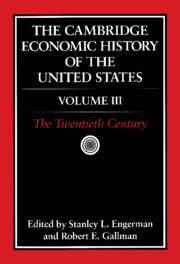Book contents
- Frontmatter
- 1 American Macroeconomic Growth in the Era of Knowledge-Based Progress: The Long-Run Perspective
- 2 Structural Changes: Regional and Urban
- 3 Twentieth-Century Canadian Economic History
- 4 The Twentieth-Century Record of Inequality and Poverty in the United States
- 5 The Great Depression
- 6 War and the American Economy in the Twentieth Century
- 7 U.S. Foreign Trade and Trade Policy in the Twentieth Century
- 8 U.S. Foreign Financial Relations in the Twentieth Century
- 9 Twentieth-Century American Population Growth
- 10 Labor Markets in the Twentieth Century
- 11 Labor Law
- 12 The Transformation of Northern Agriculture, 1910–1990
- 13 Banking and Finance in the Twentieth Century
- 14 Twentieth-Century Technological Change
- 15 The U.S. Corporate Economy in the Twentieth Century
- 16 Government Regulation of Business
- 17 The Public Sector
- Bibliographic Essays
- Index
- References
12 - The Transformation of Northern Agriculture, 1910–1990
Published online by Cambridge University Press: 28 March 2008
- Frontmatter
- 1 American Macroeconomic Growth in the Era of Knowledge-Based Progress: The Long-Run Perspective
- 2 Structural Changes: Regional and Urban
- 3 Twentieth-Century Canadian Economic History
- 4 The Twentieth-Century Record of Inequality and Poverty in the United States
- 5 The Great Depression
- 6 War and the American Economy in the Twentieth Century
- 7 U.S. Foreign Trade and Trade Policy in the Twentieth Century
- 8 U.S. Foreign Financial Relations in the Twentieth Century
- 9 Twentieth-Century American Population Growth
- 10 Labor Markets in the Twentieth Century
- 11 Labor Law
- 12 The Transformation of Northern Agriculture, 1910–1990
- 13 Banking and Finance in the Twentieth Century
- 14 Twentieth-Century Technological Change
- 15 The U.S. Corporate Economy in the Twentieth Century
- 16 Government Regulation of Business
- 17 The Public Sector
- Bibliographic Essays
- Index
- References
Summary
INTRODUCTION
American farms and farmers ”ain’t what they used to be.” To start with, there are not so many of them. In 1910, 32 million people, comprising 35 percent of the nation’s population, lived on 6.4 million farms. By 1990 only 1.8 percent of the U.S. population (4.6 million people), remained on America’s 2.1 million farms. Although dwindling in numbers, the remaining farm work force is highly productive; in 1990, the typical farm worker produced fifteen times as much as his counterpart in 1910. Over this period, the differences between farmers and non-farmers have diminished, so it is now difficult even to define either the farm sector or who is a farmer. Today one-half of people who work on northern farms do not live on farms, and one-half of the people who live on farms work off farms. In 1989 the average income per northern farm was $46,500; but 51 percent came from non-farm sources and another 12 percent from government payments.
Powerful forces have reshaped northern agriculture. Mechanical and biological innovations dramatically increased farm productivity and changed the nature of farm work. The transportation and communication revolutions integrated the farm with the rest of society. The growth in non-farm wages put enormous pressure on agricultural labor markets. And twenty years of depression forged a new farm policy. In 1910 northern agriculture closely approximated the competitive ideal; today it is a highly regulated industry. Federal programs originally justified as emergency measures have proven very difficult to end as Jefferson’s once resourceful farmers have become dependent on government handouts.
- Type
- Chapter
- Information
- The Cambridge Economic History of the United States , pp. 693 - 742Publisher: Cambridge University PressPrint publication year: 2000
References
- 10
- Cited by



